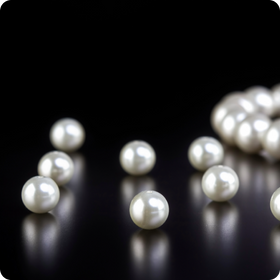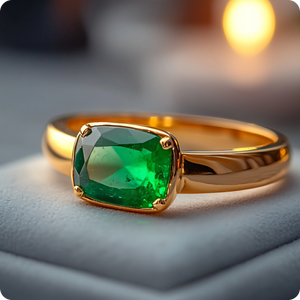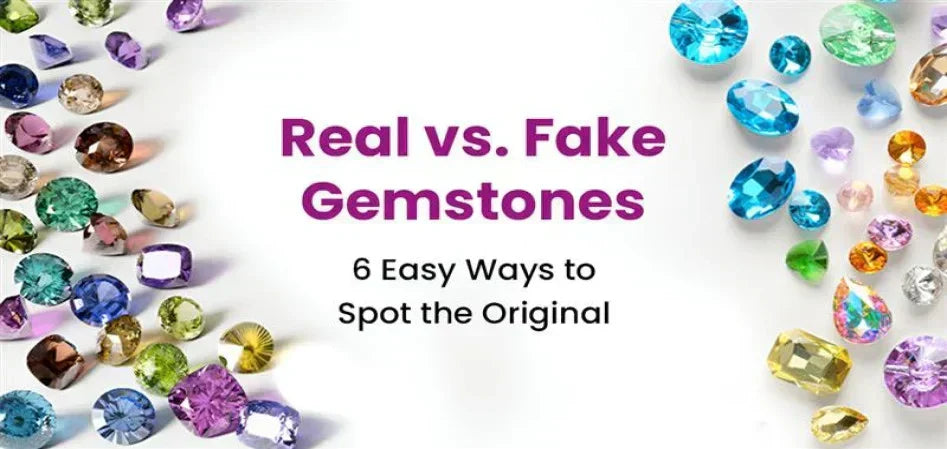Beauty is frequently deceiving in the colourful world of precious and semi-precious stones. Buyers now find it more difficult to tell real gemstones from fakes due to developments in imitation and synthetic manufacturing techniques. Finding genuine gemstones is crucial whether you're an investor, a gemstone collector, or someone looking for astrological benefits.
With the help of this thorough gemstone test guide, you can make confident and well-informed purchases by learning six infallible techniques to distinguish genuine gemstones from fakes. Even if you're not a gemmologist, these gemstone authentication strategies will help you uncover the mysteries of real stones.
Importance of Knowing Real vs Fake Gemstones
Imitations abound in the gemstone market: glass, plastic, dyed quartz, synthetic stones, and processed materials that appear strikingly natural but are not genuine or valuable. Purchasing imitation gemstones might cost you not just money but also the spiritual advantages that come with real stones.
Understanding how to distinguish genuine jewels from imitations:
- Safeguards your monetary investment.
- Guarantees the astrological or spiritual efficacy of the stone.
- Assists you in making informed purchases from trustworthy sources.
Let's discover the best gemstone authentication advice that every purchaser needs to be aware of.
6 Ways to Check Real vs Fake Gemstones
Visual Inspection: Clarity, Colour, and Inclusions
Using your eyes to recognise genuine gemstones is the first step. Rarely are natural gemstones flawless. Unlike synthetic or imitation stones, they frequently include minute inclusions, colour zoning, or inherent flaws.
What to Look for
- Inclusions: Tiny internal defects or inclusions are common in natural stones. Fake ones typically have air bubbles or are perfect, especially if they are made of glass.
- Colour: Although genuine gemstones can have vivid hues, they frequently show minor variances. The colour of fake stones is typically consistent and overly flawless.
- Shine: Genuine gemstones have a distinct depth of gleam. For example, genuine emeralds have a soft, almost smooth sheen, whereas imitations may seem excessively shiny or glassy.
The Weight Test: Density
Real gemstones weigh a certain amount because of their unique densities. Typically, fake stones composed of glass, resin, or plastic are lighter.
How to Test
- Place the gemstone in your hand or contrast it with another genuine stone that is the same size and form.
- Because of their greater density, real gemstones frequently feel heavier.
Real-World Example
Compared to a glass or synthetic sapphire of the same size, a real sapphire will weigh significantly more. It's most likely phoney if it feels excessively light.
When purchasing loose stones or beads in large quantities, this gemstone test guide tip is really beneficial.
Scratch Test: Hardness of The Stone
According to the Mohs scale, each gemstone has a unique hardness. For instance, quartz is ranked about seven, diamonds at ten, and sapphires and rubies at nine. To determine the legitimacy of the stone, you can carefully conduct a basic scratch test at home.
Method
- Use a lower-hardness object, such as a copper coin, to try lightly scratching the stone.
- Softer imitations could have scratches, but genuine gemstones won't.
Be careful of
- Unless you are testing inexpensive or suspected fakes, don't scratch pricey jewels directly. This is a last resort test that is best left to experts.
- One of the oldest methods for authenticating gemstones that has been used for millennia is this one.
The Fog Test: Heat and Breath
The fog test is among the simplest do-it-yourself methods for testing gemstones. While artificial stones hold heat longer, real stones release it more rapidly.
Method
- Breathe on the stone while holding it, simulating fogging a mirror.
- A genuine gemstone will become clear in 1-2 seconds.
- Glass in particular will remain hazy for at least five seconds.
Without any instruments, this is a very fast method for telling real gemstones from fakes in a market or store.
UV Light Test: Glow of the Stone
Many gemstones can reveal their secret nature when exposed to ultraviolet (UV) light. Under UV light, some real stones glow differently than imitations.
Examples
- When exposed to UV light, real diamonds usually glow blue.
- Fake diamonds frequently exhibit a different colour or no fluorescence.
- Red or pink fluorescence can be seen in sapphires and rubies.
- Typically, emeralds don't fluoresce; if they do, it may be artificial.
What You Need
- This test can be aided by a basic UV torch or blacklight that can be purchased online.
- Gem labs frequently employ this gemstone test guide technique, which is simply adaptable for initial inspections at home.
Gemmological Report for Clarity
Nothing compares to a certified lab result, regardless of how many tactics you try. Always request a certificate from an accredited gemological lab before buying a gemstone that costs more than a few thousand rupees or dollars.
What to Look for in a Certificate
- Type and variation of stone (e.g., untreated emerald, natural ruby).
- Origin (if any).
- treatments (such as oil-filled or heat-treated).
- GIA, IGI, GRS, IGS, or a national gem testing lab are examples of certification bodies.
High-quality synthetic or treated stones might evade even the greatest gemstone authentication advice, so a certificate is your best bet.
Common Fake Gemstone Types to Look
Some of the common fake gemstones types to watch out for and keep a look at while looking and understanding gemstone authentication tips:
Glass or Resin Immitations
These are the most popular imitation gemstones; they are made to resemble actual stones using coloured glass or artificial resin. They frequently lack natural inclusions and seem overly glossy or perfect. They can be easily identified with a straightforward visual or scratch test since they are lighter and more prone to scratches.
Synthetic Gemstones
Synthetic gemstones are created in labs and are identical to real ones in terms of their chemical makeup. They may even pass some physical tests and have a virtually comparable appearance to real stones. They do not, however, have natural flaws and geological background that can be determined by professional examination or certification.
Dyed Stones
Often, inexpensive stones like agate or quartz are dyed to look like vivid sapphires, emeralds, or rubies. Over time, the colour may bleed or fade, especially when exposed to heat or water, and it may seem overly intense or homogeneous. The dye may be visible with close examination or soaking in warm water.
Doublets and Triplets
A small slice of genuine gemstone is fused with glass or another substance underneath to create these layered stones. They are frequently used to mimic the true look of opals and emeralds while lowering costs. If you look closely from the side, you can see the glue lines or layers.
Preventive Buying Measures
Here are some more guidelines to protect your investment in addition to the gemstone test guide mentioned above:
Purchase from reputable sellers at all times
Select gemstone sellers or jewellers who have a good track record, validated ratings, and clear return policies. Reputable vendors, both online and off, will provide certification and be happy to answer your enquiries.
Examine costs
The price is most likely fraudulent if it looks too wonderful to be true. The value of real gemstones is determined by the market. Stones that are heavily discounted or appear suspiciously inexpensive should be handled carefully.
Verify the setting quality of the jewellery
Seldom are genuine gemstones put on subpar metal. A warning sign is if you're purchasing a "ruby ring" set in brass or a subpar alloy.
Conclusion
It doesn't take an expert to distinguish between real and imitation gemstones, but it does take awareness, observation, and a little perseverance. You may confidently and clearly navigate the gemstone market with these six simple, useful strategies.
Use these gemstone authentication suggestions to help you decide whether to purchase for investment, astrological purposes, or beauty. Additionally, keep in mind that you should always choose a certified stone from a reliable source when in doubt.
When you think of buying real gemstone online, make sure you are working with a reliable platform such as GemsRoot that has lab-certified gemstones, worldwide shipping, and transparent and unmatched prices. You’ll get all the varieties at a reasonable price with proper guidance and quality assurance. You can contact us at +91 114-314-8316. We also offer gemstone recommendation for a better understanding of what to wear and how to purchase the stone. Contact us to know more!
FAQs
Why is it important to know the difference between real and fake gemstones?
Knowing how to identify real gemstones helps protect your investment, ensures the stone’s astrological effectiveness, and prevents losses from fake or synthetic imitations.
What are the common signs of fake gemstones?
Fake gemstones often appear too perfect, with no inclusions, overly consistent color, glassy shine, and lighter weight compared to genuine natural stones.
How can I test if my gemstone is real at home?
Simple tests include visual inspection for inclusions, the fog test, the weight test, the scratch test, and checking under UV light. However, professional certification is always recommended.
What is the fog test for gemstones?
The fog test involves breathing on the stone like fogging a mirror. A genuine gemstone clears within 1–2 seconds, while fakes like glass stay hazy for longer.
Can weight help identify a real gemstone?
Yes, real gemstones are denser and feel heavier than fakes of the same size, such as glass or resin imitations which feel unusually light.
Do synthetic gemstones count as fake?
Synthetic gemstones are lab-created with the same chemical composition as natural ones. While not “fake,” they lack the natural flaws, history, and often the same value as genuine stones.
What are dyed stones and how to identify them?
Dyed stones are cheaper gems like agate or quartz treated with artificial color. Over time, the dye may fade, bleed, or appear overly bright and uniform.
What are doublets and triplets in gemstones?
Doublets and triplets are layered stones where a thin slice of natural gem is fused with glass or other material. Glue lines or layering are often visible from the side.
How can certification help in gemstone authentication?
A certificate from a recognized gemological lab (like GIA, IGI, or GRS) verifies authenticity, treatments, and origin, making it the most reliable method of identifying real gemstones.
Where should I buy genuine gemstones?
Always buy from trusted sellers like GemsRoot, which provide lab-certified, untreated gemstones with transparent pricing, expert guidance, and a quality guarantee.

 Emerald (Panna)
Emerald (Panna)
 Ruby (Manik)
Ruby (Manik)
 Yellow Sapphire (Pukhraj)
Yellow Sapphire (Pukhraj)
 Blue Sapphire (Neelam)
Blue Sapphire (Neelam)
 White Sapphire (Safed Pukhraj)
White Sapphire (Safed Pukhraj)
 Hessonite (Gomed)
Hessonite (Gomed)
 Red Coral (Moonga)
Red Coral (Moonga)
 Pearl (Moti)
Pearl (Moti)
 Cats Eye (Lahsuniya)
Cats Eye (Lahsuniya)
 Opal (Dudhiya Pathar)
Opal (Dudhiya Pathar)
 Red Garnet (Rakt Mani)
Red Garnet (Rakt Mani)
 Moonstone (Chandrakant)
Moonstone (Chandrakant)
 Carnelian (Rat-Ratua)
Carnelian (Rat-Ratua)
 Peridot (Mani Stone)
Peridot (Mani Stone)
 Green Onyx (Sulemani)
Green Onyx (Sulemani)
 Jade (Crassula)
Jade (Crassula)
 Citrine (Sunela)
Citrine (Sunela)
 Amethyst (Jamunia)
Amethyst (Jamunia)
 Aries (Mesh)
Aries (Mesh)
 Taurus (Vrushabh)
Taurus (Vrushabh)
 Gemini (Mithun)
Gemini (Mithun)
 Cancer (Kark)
Cancer (Kark)
 Leo (Sinh)
Leo (Sinh)
 Virgo (Kanya)
Virgo (Kanya)
 Libra (Tula)
Libra (Tula)
 Scorpio (Vrishchik)
Scorpio (Vrishchik)
 Sagittarius (Dhanu)
Sagittarius (Dhanu)
 January Birthstone
January Birthstone
 February Birthstone
February Birthstone
 March Birthstone
March Birthstone
 April Birthstone
April Birthstone
 May Birthstone
May Birthstone
 June Birthstone
June Birthstone
 July Birthstone
July Birthstone
 August Birthstone
August Birthstone
 September Birthstone
September Birthstone
 October Birthstone
October Birthstone
 November Birthstone
November Birthstone
 December Birthstone
December Birthstone

 Emerald Rings
Emerald Rings
 Yellow Sapphire Rings
Yellow Sapphire Rings
 Blue Sapphire Rings
Blue Sapphire Rings
 Ruby Rings
Ruby Rings
 Red Coral Rings
Red Coral Rings
 Pearl Ring
Pearl Ring
 White Sapphire Ring
White Sapphire Ring
 Amethyst Ring
Amethyst Ring
 Aquamarine Ring
Aquamarine Ring
 Blue Topaz Ring
Blue Topaz Ring
 Silver Jewellery
Silver Jewellery
 Gold Jewellery
Gold Jewellery
 Panchdhatu Jewellery
Panchdhatu Jewellery
 Rose Gold Jewellery
Rose Gold Jewellery
 Platinum Jewellery
Platinum Jewellery



